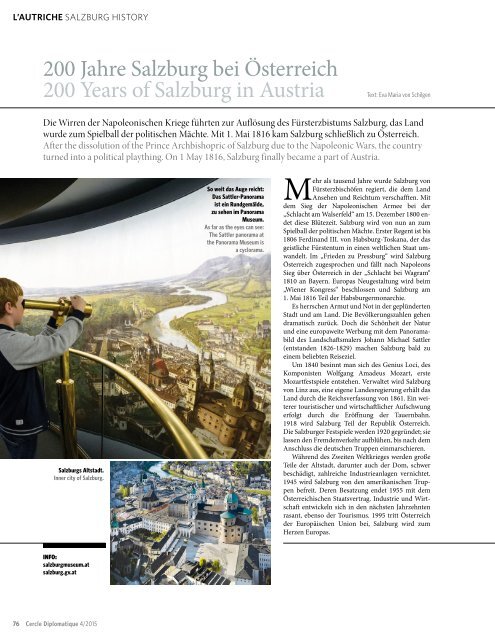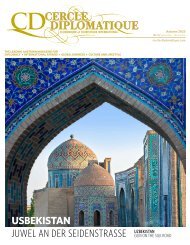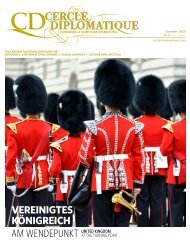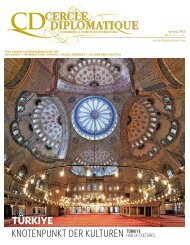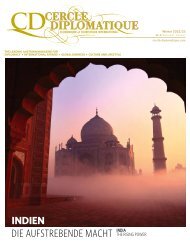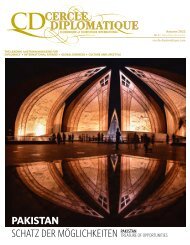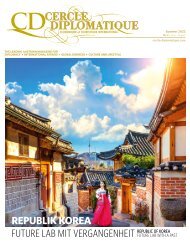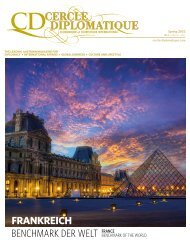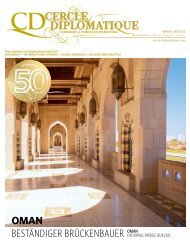CERCLE DIPLOMATIQUE - issue 04/2015
CD is an independent and impartial magazine and is the medium of communication between foreign representatives of international and UN-organisations based in Vienna and the Austrian political classes, business, culture and tourism. CD features up-to-date information about and for the diplomatic corps, international organisations, society, politics, business, tourism, fashion and culture. Furthermore CD introduces the new ambassadors in Austria and informs about designations, awards and top-events. Interviews with leading personalities, country reports from all over the world and the presentation of Austria as a host country complement the wide range oft he magazine.
CD is an independent and impartial magazine and is the medium of communication between foreign representatives of international and UN-organisations based in Vienna and the Austrian political classes, business, culture and tourism. CD features up-to-date information about and for the diplomatic corps, international organisations, society, politics, business, tourism, fashion and culture. Furthermore CD introduces the new ambassadors in Austria and informs about designations, awards and top-events. Interviews with leading personalities, country reports from all over the world and the presentation of Austria as a host country complement the wide range oft he magazine.
You also want an ePaper? Increase the reach of your titles
YUMPU automatically turns print PDFs into web optimized ePapers that Google loves.
L’AUTRICHE SALZBURG HISTORY<br />
200 Jahre Salzburg bei Österreich<br />
200 Years of Salzburg in Austria<br />
Die Wirren der Napoleonischen Kriege führten zur Auflösung des Fürsterzbistums Salzburg, das Land<br />
wurde zum Spielball der politischen Mächte. Mit 1. Mai 1816 kam Salzburg schließlich zu Österreich.<br />
After the dissolution of the Prince Archbishopric of Salzburg due to the Napoleonic Wars, the country<br />
turned into a political plaything. On 1 May 1816, Salzburg finally became a part of Austria.<br />
Salzburgs Altstadt.<br />
Inner city of Salzburg.<br />
INFO:<br />
salzburgmuseum.at<br />
salzburg.gv.at<br />
76 Cercle Diplomatique 4/<strong>2015</strong><br />
So weit das Auge reicht:<br />
Das Sattler-Panorama<br />
ist ein Rundgemälde,<br />
zu sehen im Panorama<br />
Museum.<br />
As far as the eyes can see:<br />
The Sattler panorama at<br />
the Panorama Museum is<br />
a cyclorama.<br />
Text: Eva Maria von Schilgen<br />
Mehr als tausend Jahre wurde Salzburg von<br />
Fürsterzbischöfen regiert, die dem Land<br />
Ansehen und Reichtum verschafften. Mit<br />
dem Sieg der Napoleonischen Armee bei der<br />
„Schlacht am Walserfeld“ am 15. Dezember 1800 endet<br />
diese Blütezeit. Salzburg wird von nun an zum<br />
Spielball der politischen Mächte. Erster Regent ist bis<br />
1806 Ferdinand III. von Habsburg-Toskana, der das<br />
geistliche Fürstentum in einen weltlichen Staat umwandelt.<br />
Im „Frieden zu Pressburg“ wird Salzburg<br />
Österreich zugesprochen und fällt nach Napoleons<br />
Sieg über Österreich in der „Schlacht bei Wagram“<br />
1810 an Bayern. Europas Neugestaltung wird beim<br />
„Wiener Kongress“ beschlossen und Salzburg am<br />
1. Mai 1816 Teil der Habsburgermonarchie.<br />
Es herrschen Armut und Not in der geplünderten<br />
Stadt und am Land. Die Bevölkerungszahlen gehen<br />
dramatisch zurück. Doch die Schönheit der Natur<br />
und eine europaweite Werbung mit dem Panoramabild<br />
des Landschaftsmalers Johann Michael Sattler<br />
(entstanden 1826-1829) machen Salzburg bald zu<br />
einem beliebten Reiseziel.<br />
Um 1840 besinnt man sich des Genius Loci, des<br />
Komponisten Wolfgang Amadeus Mozart, erste<br />
Mozartfestspiele entstehen. Verwaltet wird Salzburg<br />
von Linz aus, eine eigene Landesregierung erhält das<br />
Land durch die Reichsverfassung von 1861. Ein weiterer<br />
touristischer und wirtschaftlicher Aufschwung<br />
erfolgt durch die Eröffnung der Tauernbahn.<br />
1918 wird Salzburg Teil der Republik Österreich.<br />
Die Salzburger Festspiele werden 1920 gegründet; sie<br />
lassen den Fremdenverkehr aufblühen, bis nach dem<br />
Anschluss die deutschen Truppen einmarschieren.<br />
Während des Zweiten Weltkrieges werden große<br />
Teile der Altstadt, darunter auch der Dom, schwer<br />
beschädigt, zahlreiche Industrieanlagen vernichtet.<br />
1945 wird Salzburg von den amerikanischen Truppen<br />
befreit. Deren Besatzung endet 1955 mit dem<br />
Österreichischen Staatsvertrag. Industrie und Wirtschaft<br />
entwickeln sich in den nächsten Jahrzehnten<br />
rasant, ebenso der Tourismus. 1995 tritt Österreich<br />
der Europäischen Union bei, Salzburg wird zum<br />
Herzen Europas.<br />
PHOTOS: BRYAN REINHART, TOURISMUS SALZBURG GMBH<br />
For more than a thousand years, Salzburg was<br />
ruled by prince archbishops who secured<br />
prestige and wealth. This heyday ended with the<br />
victory of the Napoleonic army during the „Battle of<br />
Walserfeld“ on 15 December 1800. Salzburg was<br />
henceforth at the mercy of political powers. The first<br />
ruler was Ferdinand III. of Habsburg-Tuscany until<br />
1806, who converted the ecclesiastical principality into<br />
a secular state. In the „Peace of Pressburg“, Salzburg<br />
was awarded to Austria but after Napoleon’s victory<br />
over Austria in the „Battle of Wagram“ in 1810, became<br />
a part of Bavaria. Europe’s redesign was decided at the<br />
„Congress of Vienna“, and on 1 May 1816, Salzburg<br />
was included into the Habsburg monarchy.<br />
Poverty and misery gripped the looted city and<br />
countryside. The population diminished dramatically.<br />
Salzburg soon grew into a popular destination<br />
due to the beauty of its nature and a pan-European<br />
advertisement with the panoramic image by landscape<br />
painter Johann Michael Sattler (painted between<br />
1826 and 1829).<br />
In 1840 the ‘genius loci’, composer Wolfgang<br />
Amadeus Mozart, was remembered and the first Mozart<br />
Festival was run. Salzburg was governed from<br />
Linz, and it secured its own provincial government<br />
as a result of the imperial constitution of 1861.<br />
Another tourist and economic boom was effected<br />
by the opening of the Tauern Railway. In 1918, Salzburg<br />
was united with the Republic of Austria. The<br />
Salzburg Festival was established in 1920, which<br />
made tourism thrive until the German troops marched<br />
in.<br />
During the Second World War, large parts of the<br />
old town – including the Cathedral – were heavily<br />
damaged, and numerous industrial plants destroyed.<br />
American troops liberated Salzburg in 1945. Their<br />
occupation ended in 1955 with the Austrian State<br />
Treaty. Industry, business and tourism developed rapidly<br />
in the coming decades. Austria entered the European<br />
Union in 1995, making Salzburg the heart of<br />
Europe.<br />
Land im Wandel<br />
Changing country<br />
Das DomQuartier Salzburg – „Mehr als ein Museum“<br />
Der 1,3 Kilometer lange DQ-Rundgang folgt den Spuren der Salzburger Fürsterzbischöfe durch den<br />
Dom-und Residenzbereich. Er führt vorbei an Kunstschätzen aus den reichen Sammlungen des Landes, der<br />
Erzdiözese und der Erzabtei und bietet aufsehenerregende Sonderausstellungen: So eröffnet eine Ausstellung<br />
über spätmittelalterliche Salzburger Buchmalerei nicht nur einen Blick auf prächtige Bücher, sondern bietet<br />
auch die seltene Gelegenheit, jahrhunderte alte Manuskripte im Original zu betrachten. In „Vedi Napoli“<br />
kann man der spezifischen Reisekultur der Benediktinermönche erstmals in einer umfassenden Ausstellung<br />
und anhand hochkarätiger Exponate aus über 1200 Jahren nachspüren. Ab Juli 2016 ist eine erlesene<br />
Auswahl an Spitzenwerken der Sammlung „Liechtenstein. The Princley Collections“ in Kooperation mit der<br />
Residenzgalerie Salzburg und der Akademie der bildenden Künste Wien (Gemäldegalerie) zu bestaunen. Mit<br />
dieser Schau kann sich Salzburg im Sommer 2016 nicht nur als die Festspielstadt, sondern auch als exquisiter<br />
Ausstellungsort präsentieren.<br />
DOMQUARTIER SALZBURG • Residenzplatz 1 / Domplatz 1a<br />
5020 Salzburg • Tel. + 43 (0) 662- 8<strong>04</strong>2-2109<br />
Täglich geöffnet, außer Di, 10-17 Uhr • 1.12.<strong>2015</strong>–6.1.2016 täglich geöffnet<br />
Juli, August: täglich geöffnet, Mi bis 20 Uhr<br />
www.domquartier.at<br />
„Bischof. Kaiser. Jedermann. 200 Jahre Salzburg bei Österreich“ heißt die vom Salzburg Museum<br />
konzipierte Landesausstellung. Vom 30. April bis 30. Oktober 2016 erhalten Besucher im Rahmen<br />
einer Ausstellungstrilogie einen Einblick in die wechselvolle Geschichte des Bundeslandes.<br />
Das Jubiläumsjahr dient aber auch als Anlass, um Zukunftsweisendes für die weitere Entwicklung<br />
Salzburgs in den Bereichen Arbeit und Wirtschaft, Soziales und Gemeinden, Kultur und Bildung in<br />
den Mittelpunkt zu stellen. Mit dem Wettbewerb „Salzburger Zukunftslabor“ sind Privatpersonen,<br />
Vereine, Gemeinden, Unternehmen, Kultureinrichtungen und Schulen aufgefordert, für künftige<br />
Herausforderungen Lösungsmodelle zu entwickeln. Bis 16. Dezember läuft die Bewerbungsfrist,<br />
eine Experten-Jury kürt dann im Jänner 2016 die Siegerprojekte.<br />
„Bishop. Emperor. Jedermann. 200 years Salzburg in Austria“ is the national exhibition presented<br />
by the Salzburg Museum. In an exhibition trilogy from 30 April to 30 October 2016, visitors will<br />
receive insight into the eventful history of Salzburg. However, the jubilee year also serves as an<br />
occasion to put trendsetting for the further development of Salzburg in the areas of work and<br />
economy, social affairs and municipalities, culture and education in the centre. With the<br />
competition „Salzburg future lab“ private individuals, associations, municipalities, enterprises,<br />
cultural facilities and schools are asked to develop solution models for future challenges. The<br />
application term runs till December 16, then a jury of experts chooses the winning projects in<br />
January 2016.<br />
zukunftslabor-salzburg2016.at<br />
2016 zu Gast in Salzburg:<br />
Rubens berühmtes Porträt der Clara Serena Rubens<br />
© LIECHTENSTEIN. The Princely Collections.


